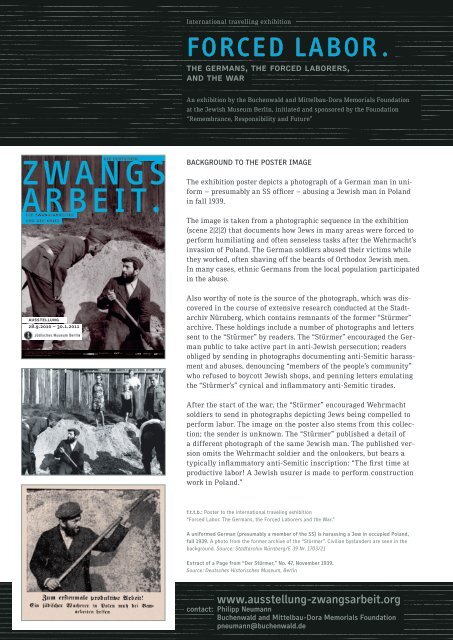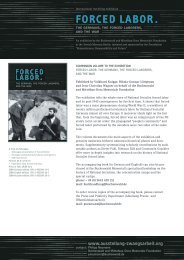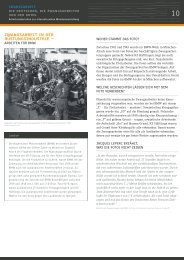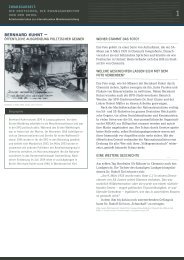FORCED LABOR . - Ausstellung Zwangsarbeit
FORCED LABOR . - Ausstellung Zwangsarbeit
FORCED LABOR . - Ausstellung Zwangsarbeit
- No tags were found...
Create successful ePaper yourself
Turn your PDF publications into a flip-book with our unique Google optimized e-Paper software.
Eine <strong>Ausstellung</strong> der Stiftung Gedenkstätten Buchenwald und Mittelbau-Doraim Jüdischen Museum Berlin, initiiert und gefördert von der Stiftung „Erinnerung, Verantwortung und Zukunft“Schirmherrschaft: Bundespräsident Christian WulffMedienpartner:International travelling exhibitionforced labor .the germans, the forced laborers,and the warAn exhibition by the Buchenwald and Mittelbau-Dora Memorials Foundationat the Jewish Museum Berlin, initiated and sponsored by the Foundation“Remembrance, Responsibility and Future”die deutschen,Background to the Poster ImageThe exhibition poster depicts a photograph of a German man in uniform– presumably an SS officer – abusing a Jewish man in Polandin fall 1939.die zwangsarbeiterund der kriegThe image is taken from a photographic sequence in the exhibition(scene 2|2|2) that documents how Jews in many areas were forced toperform humiliating and often senseless tasks after the Wehrmacht’sinvasion of Poland. The German soldiers abused their victims whilethey worked, often shaving off the beards of Orthodox Jewish men.In many cases, ethnic Germans from the local population participatedin the abuse.ausstellung28.9.2010 – 30.1.2011Foto: Stadtarchiv Nürnberg/Signatur E 39 Nr. 1703/21. Gestaltung: gewerk design, BerlinAlso worthy of note is the source of the photograph, which was discoveredin the course of extensive research conducted at the StadtarchivNürnberg, which contains remnants of the former “Stürmer”archive. These holdings include a number of photographs and letterssent to the “Stürmer” by readers. The “Stürmer” encouraged the Germanpublic to take active part in anti-Jewish persecution; readersobliged by sending in photographs documenting anti-Semitic harassmentand abuses, denouncing “members of the people’s community”who refused to boycott Jewish shops, and penning letters emulatingthe “Stürmer’s” cynical and inflammatory anti-Semitic tirades.After the start of the war, the “Stürmer” encouraged Wehrmachtsoldiers to send in photographs depicting Jews being compelled toperform labor. The image on the poster also stems from this collection;the sender is unknown. The “Stürmer” published a detail ofa different photograph of the same Jewish man. The published versionomits the Wehrmacht soldier and the onlookers, but bears atypically inflammatory anti-Semitic inscription: “The first time atproductive labor! A Jewish usurer is made to perform constructionwork in Poland.”f.t.t.b.: Poster to the international traveling exhibition“Forced Labor. The Germans, the Forced Laborers and the War.”A uniformed German (presumably a member of the SS) is harassing a Jew in occupied Poland,fall 1939. A photo from the former archive of the “Stürmer”. Civilian bystanders are seen in thebackground. Source: Stadtarchiv Nürnberg/E 39 Nr. 1703/21Extract of a Page from “Der Stürmer,” No. 47, November 1939.Source: Deutsches Historisches Museum, Berlinwww.ausstellung-zwangsarbeit.orgcontact: Philipp NeumannBuchenwald and Mittelbau-Dora Memorials Foundationpneumann@buchenwald.de
International travelling exhibitionforced labor .the germans, the forced laborers,and the warAn exhibition by the Buchenwald and Mittelbau-Dora Memorials Foundationat the Jewish Museum Berlin, initiated and sponsored by the Foundation“Remembrance, Responsibility and Future”Companion volume to the exhibitionForced labor. The germans, the forced laborers,and the warthe germans, the forced laborers,and the warPublished by Volkhard Knigge, Rikola-Gunnar Lüttgenauand Jens-Christian Wagner on behalf of the Buchenwaldand Mittelbau-Dora Memorials FoundationF o r c e d l a b o r .the germans, the forced laborers, and the warA total of 256 pages:– 180 pages presentation of the exhibition– 65 pages systematizing scholarly contributions– 188 illustrationsFormat: 20.5 x 27.5 cm– Paperback with thread stitchingPrice of sale: 19,80 euroISBN German edition: 3-935598-17-3ISBN English edition: 3-935598-18-1The exhibition tells the whole story of National Socialist forced laborand its post-1945 consequences for the first time. It shows that forcedlabor was a mass phenomenon: during World War II, a workforce oftwenty million performed involuntary labor for National SocialistGermany almost all over Europe. It moreover sheds light on the factthat, from the beginning, forced labor was an integral part of the NSstate’s racist social order: the propagated “people’s community” andforced labor performed by the outsiders were two sides of the samecoin.This volume documents the main aspects of the exhibition andpresents numerous hitherto unknown historical photos and documents.Supplementary systematizing scholarly contributions by suchnotable authors as Dieter Pohl, Dietmar Süß and Constantin Goschleroffer more in-depth insights into research on the history of NationalSocialist forced labor.The accompanying book (in German and English) can also be purchasedat the Buchenwald Memorial’s specialized bookshop on thehistory of National Socialism, the concentration camps and thespecial camps.phone: + 49 (0) 3643 430 151mail: buchhandlung@buchenwald.deTo order review copies of the accompanying book, please contactthe Press and Publicity Department (Abteilung Presse- undÖffentlichkeitsarbeit).mail: pneumann@buchenwald.dewww.ausstellung-zwangsarbeit.orgcontact: Philipp NeumannBuchenwald and Mittelbau-Dora Memorials Foundationpneumann@buchenwald.de
International travelling exhibitionforced labor .the germans, the forced laborers,and the warAn exhibition by the Buchenwald and Mittelbau-Dora Memorials Foundationat the Jewish Museum Berlin, initiated and sponsored by the Foundation“Remembrance, Responsibility and Future”PublicityThe exhibition focuses on the ways in which forced labor shaped dailylife under National Socialism. Forced laborers were deployed acrossGermany and in all sectors of the economy. They were a familiarpresence to all Germans, who encountered them in factories, inagricultural work, and on the street. As a result, the exhibition alsoextends into the everyday sites of contemporary life, from Berlin pubsto the city’s subway system.Nazi racial ideology shaped the relationship of Germans to the forcedlaborers. In the Nazi racial hierarchy, “Aryan” Germans occupiedthe position of the “master race,” followed by the peoples of northernand western Europe. Poles, Soviet forced laborers (or “Eastern Workers”),and finally Jews and Sinti and Roma occupied the bottom of thehierarchy.Although – or perhaps precisely because – forced labor penetratedmore deeply into daily life during the Third Reich than any otherNazi crime, postwar Germany did not grapple with the topic until the1990s.The publicity was developed andimplemented by the Weimar artistAnke Heelemann.The publicity for the forced labor exhibition tries to make the peoplewho were deported to the German Reich as forced laborers visible.Selections from the countless regulations issued by the Nazi authoritiesshow how forced laborers were subordinated in their daily livesto the racist regime. In addition, the publicity for the exhibition drawssubstantially on historical photographs – photos which the forcedlaborers took of each other during their stay in the German Reich.These photos depict forced laborers, who were deported from allover Europe, as self-aware individuals who tried to maintain theiridentity and dignity in the face of oppressive injustice. The censoredpostcards, which they sent to reassure their worried families thatthey were doing well – at least in light of their circumstances – arejuxtaposed to later memoir accounts. These recollections help contextualizethe seemingly harmless photographs and make evident thesuffering and hardship that forced laborers experienced in the GermanReich. By contrast, the photographs presented in subway stationpublicity require no additional commentary. In these photographs, theforced laborers describe their fate in their own words: as the “slavesof the 20th century” who live “without love,” or simply as “those whohad no Christmas 1944.”www.ausstellung-zwangsarbeit.orgcontact: Philipp NeumannBuchenwald and Mittelbau-Dora Memorials Foundationpneumann@buchenwald.de






